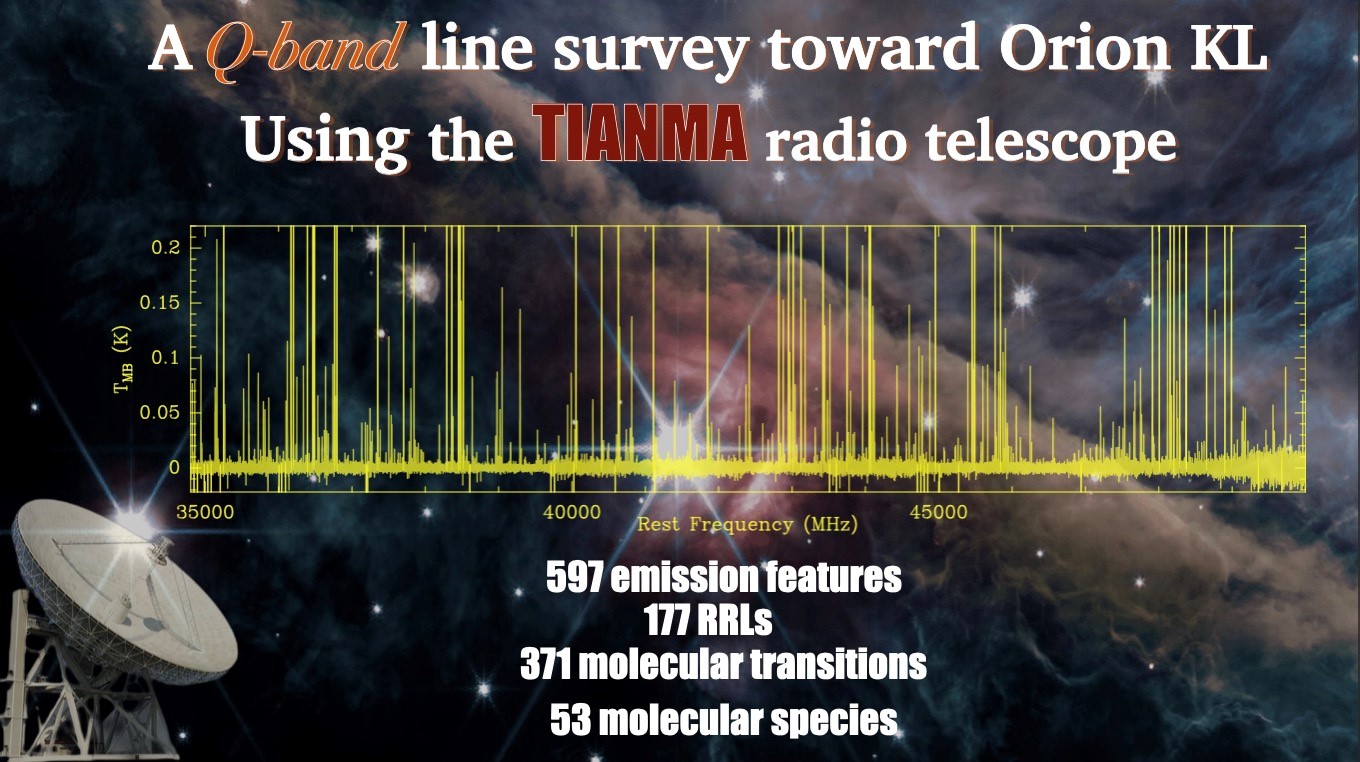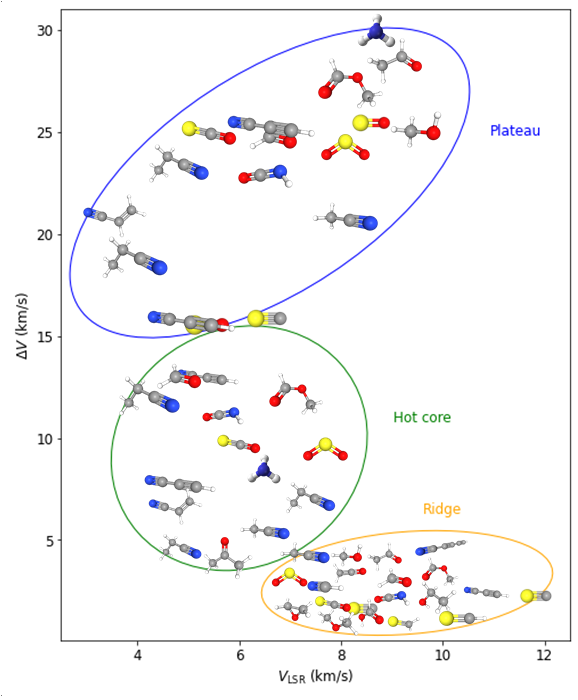A research team from Shanghai Astronomical Observatory (SHAO) has recently completed a deep Q-band line scanning survey towards Orion KL using the Tianma 65 m radio telescope (TMRT), achieving the widest frequency coverage (35--50 GHz) and the highest sensitivity (~mK) spectra so far. In total, about 600 emission lines were detected, including 177 radio recombination lines (RLLs) and 371 molecular line transitions from 53 species. Among the 53 detected molecular species, 21 ones were firmly detected for the first time in Q-band. This survey highlights the capability of TMRT in searching for weak lines within extremely large wide-band spectra. The work has been published in the Astrophysical Journal Supplement (ApJS) on Nov. 9, 2022.
Interstellar complex organic molecules (COMs) play an important role in the origin of life. Wide-band line scanning survey towards typical star-forming regions is one of the best methods to understand their physical and chemical properties, and to study the origin of COMs, especially the prebiotic ones. The Orion KL is the closest high-mas star-forming regions from us at about 1300 light-year away. It is a molecular complex interacting with an expanding HII region (M42), and it consists several gas components with various temperatures, including a cold environment gas component (<50 K), a warm compact ridge (~100 K), a hot molecular core (~200 K) and a highly shocked plateau (>500 K). Those gas components have diverse chemical properties and contribute numerous emission lines in a wide range of wavelengths, many of which are the brightest on the sky. Thus, the Orion KL is very suitable for wide-band line scanning survey. However, previous line surveys towards Orion KL are mostly conducted in short-millimeter, sub-millimeter or far-infrared bands. Line surveys in low frequency bands such as the Q band (35--50 GHz) are very rare.
In fact, the Q band have irreplaceable advantages in searching for high-Δn RRLs, new molecular transitions and even new molecules. Emission line of COMs are rich in low frequency bands thanks to their small rotational constants. Those low-frequency molecular lines tend to have lower upper-level energies, and thus are usually optically thin and not severely blended, benefiting the Q band in detecting and identifying COM species more easily. The Q band also covers many RRLs. However, for the lacking of big equipment with capability of conducting spectral line observations in Q band, these advantages have not been fully utilized.
The TMRT is located at a western suburb of Shanghai, China. It is at present the largest fully steerable radio telescope in Asian region. Receivers from L to Q band are available, covering a full frequency range of 1--50 GHz. The Q-band receiver developed by a SHAO engineer team lead by Dr. Zhong Wei-Ye provides the highest frequency coverage of Tianma 65 m. The TMRT has an active surface control utilizing actuators to compensate for gravity deformation in the main reflector during observations, and it makes the Q-band aperture efficiency constant for different elevations. The DIBAS backend is adopted, providing a bandwidth of up to 3 GHz. These factors indicate that the TMRT is very suitable for wide-band line surveys.
Recently, a research team from SHAO conducted the first deep Q-band line survey towards Orion KL with TMRT (see Figure 1). In total, about 600 emission features are extracted. Among them, 177 RRLs and 371 molecular transitions are identified. All the identified lines can be well reproduced by a radiative transfer model. The 371 molecular transitions belong to 53 kinds of molecular species, most of which are COMs. “The TMRT Q-band line survey towards Orion KL detected tremendous amount of emission lines, and two thirds of them have not been detected in previous line surveys [1],” said Xunchuan Liu, a postdoc in SHAO and the first author of the study.
When an electron is captured by an ion, it will continue to jump downward and generate a series of emission lines. Those emission lines are called radio recombination lines (RLLs) if they appear in radio regime. In the line survey of TMRT, high-Δn RRLs such as H135π and C81γ were detected. They are RRLs with the highest Δn detected in Q band. The deviation of level population from thermal-equilibrium was observed and successfully modeled. Besides, the study detected the NH3 (15,15) and (16,16). It is the first time to detect NH3 emission lines with upper-state energy greater than 2000 K towards Orion KL, indicating the existence of an extremely hot gas component in the Orion KL region. The study has also detected many COMs such as NH2CHO, CH3OCHO, C2H5CN, CH3OCH3, CH3CH2OH, CH3COCH3. These COMs are the foundation of more complex prebiotic molecules. By comparing the line parameters of the newest experimental data measured by the CDMS team in University of Cologne, researchers successfully identified the emission lines of vibrationally excited states of ethyl cyanide (C2H5CN v13/v21) in Q-band (see Figure 2). It is for the first time to detect and identify Q-band emission of C2H5CN v13/v21 from the interstellar medium. This highlights the importance of joint analysis of data from astronomical observations and lab experiments in identifying new molecular lines. The detected COMs can be assigned to different gas components of Orion KL through comparing their line widths and central velocities (see Figure 3). Aldehyde-containing species and species with both sulfur and oxygen elements tend to have spectral components originated from the plateau, and this supports a possible abundance enhancement of these species by shocks.
“This is the first wide-band deep line scanning survey conducted by a Chinese radio facility, and this survey reaches an unprecedented line sensitivity that demonstrates the huge potential of TMRT in astrochemistry studies,” said Tie Liu, a researcher in SHAO and co-corresponding author of the study. “This Q-band deep line survey provides excellent guides for similar line scanning survey in Q-band towards other targets,” added Sheng-Li Qin, a professor in Yunnan University and co-author of the study. In the future, the research team will conduct a deeper line survey towards Orion KL, aiming to achieving a sensitivity of better than mK and extending the frequency coverage to the full Q/Ka band (26--50 GHz). Furthermore, the research team also plans to conduct line surveys in Q/Ka band towards a much larger sample of COM-rich sources using the TMRT. The follow-up surveys will build an unprecedented gallery of Q/Ka-band spectra of typical COM-rich sources, and help to identify new COMs, especially the prebiotic species.
“This work indicates that we can use Chinese domestic radio telescopes to conduct first-class astrochemical studies. The TMRT, especially its receiving system, is being greatly updated, and it will play a more important role in promoting the development of radio astronomy in China.” concluded by Zhiqiang Shen, the director of SHAO and a co-corresponding author of the study.
Figure 1: The Q-band spectra of Orion KL observed by TMRT. The background is the near-infrared image of Orion A obtained by JWST (credit: NASA/ESA/CSA), and Orion KL locates just beside the central brightest star. Lower-left corner shows the picture of TMRT. (The composed figure is made by Qiuyi Luo)
Figure 2: The comparison between the spectra of TMRT in blue and of Rizzo et al. (2017) in orange. The red lines represent the results of model fitting. The upper panel shows the example spectrum within 45.8--46.0 GHz. The lower panel shows the detected lines of C2H5CN v13/v21 .
Figure 3: The distribution of different species in the velocity-linewidth diagram. The three ellipses represent different gas components of Orion KL.
Reference:
[1] Rizzo, J. R., Tercero, B., & Cernicharo, J. 2017, A&A, 605, A76
Link of the study:
Contact authors:
Xunchuan Liu,, SHAO, liuxunchuan@shao.ac.cn
Tie Liu, SHAO, liutie@shao.ac.cn
Zhiqiang Shen, SHAO, zshen@shao.ac.cn


